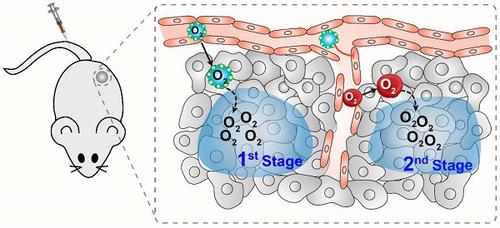Theranostics ( IF 12.4 ) Pub Date : 2018-09-09 , DOI: 10.7150/thno.27598 Zaigang Zhou 1, 2 , Baoli Zhang 1, 2 , Haoran Wang 1, 2 , Ahu Yuan 1, 2 , Yiqiao Hu 1, 2, 3 , Jinhui Wu 1, 2, 3

|
Tumors are usually hypoxic, which limits the efficacy of current tumor therapies, especially radiotherapy in which oxygen is essential to promote radiation-induced cell damage. Herein, by taking advantage of the ability of perfluorocarbon (PFC) to promote red blood cell penetration, we developed a simple but effective two-stage oxygen delivery strategy to modulate the hypoxic tumor microenvironment using PFC nanoparticles.
Methods: We first examined the two-stage oxygen delivery ability of PFC nanoparticles on relieving tumor hypoxia through platelet inhibition. To evaluate the effect of PFC nanoparticles on radiation sensitization, CT26 tumor and SUM49PT tumor model were used.
Results: In this study, PFC was encapsulated into albumin and intravenously injected into tumor-bearing mice without hyperoxic breathing. After accumulation in the tumor, PFC nanoparticles rapidly released the oxygen that was physically dissolved in PFC as the first-stage of oxygen delivery. Then, PFC subsequently promoted red blood cell infiltration, which further released O2 as the second-stage of oxygen delivery.
Conclusion: The hypoxic tumor microenvironment was rapidly relieved via two-stage oxygen delivery, effectively increasing radiotherapy efficacy. The safety of all substances used in this study has been clinically demonstrated, ensuring that this simple strategy could be rapidly and easily translated into clinical applications to solve the clinical problems associated with tumor hypoxia.
Keywords: perfluorocarbon nanoparticles, tumor hypoxia, two-stage oxygen delivery, radiotherapy
中文翻译:

全氟化碳纳米颗粒增强放射治疗的两阶段氧气输送
肿瘤通常是缺氧的,这限制了当前肿瘤治疗的疗效,尤其是放疗,其中氧气对于促进辐射引起的细胞损伤至关重要。在此,通过利用全氟化碳(PFC)促进红细胞渗透的能力,我们开发了一种简单但有效的两阶段氧气输送策略,以使用PFC纳米颗粒调节缺氧的肿瘤微环境。
方法:我们首先检测了 PFC 纳米颗粒通过抑制血小板缓解肿瘤缺氧的两阶段供氧能力。为了评价PFC纳米颗粒对放射增敏的影响,使用CT26肿瘤和SUM49PT肿瘤模型。
结果:本研究将PFC封装在白蛋白中,静脉注射到无高氧呼吸的荷瘤小鼠体内。在肿瘤中积累后,PFC纳米颗粒迅速释放物理溶解在PFC中的氧气,作为氧气输送的第一阶段。然后,PFC随后促进红细胞浸润,进一步释放O 2作为氧气输送的第二阶段。
结论:两级供氧快速缓解肿瘤缺氧微环境,有效提高放疗疗效。本研究中使用的所有物质的安全性均已得到临床证明,确保这种简单的策略可以快速、轻松地转化为临床应用,以解决与肿瘤缺氧相关的临床问题。
关键词: 全氟化碳纳米颗粒, 肿瘤缺氧, 两级供氧, 放射治疗











































 京公网安备 11010802027423号
京公网安备 11010802027423号